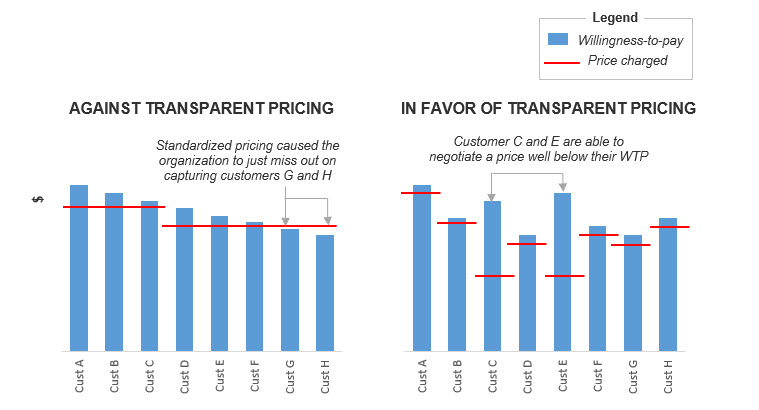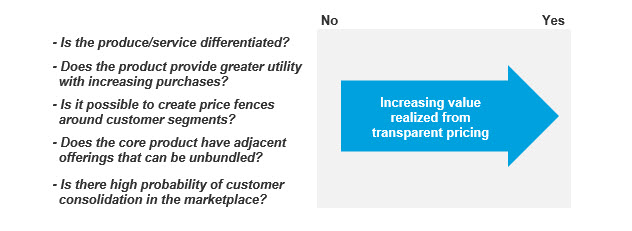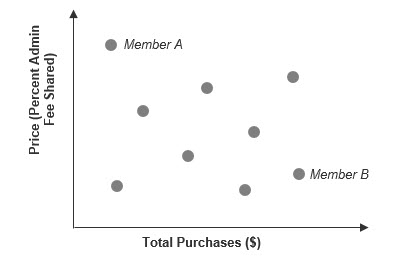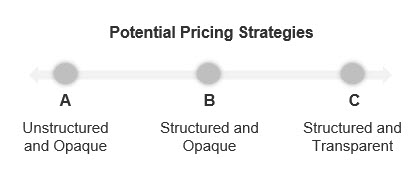
The decision of whether or not to be transparent with pricing has been a long standing debate in the commercial domain. This issue is particularly important for complex B2B sales where the customers are fewer and more sophisticated, average transaction prices are higher and the willingness-to-pay across customers can be more variable.
Opponents of transparent pricing tend to rely on two arguments. The first is centered on not wanting to reveal prices to competitors which they fear would enable the competition to undercut them. The second is the classic economic argument stating that every transaction where a customer is willing to pay a price above marginal costs is beneficial for the company as it generates positive contribution margin for the organization. By communicating a single price level they argue, you are certain to lose sales to potential customers whose reservation price was marginally lower than the threshold you happened to have set.
This line of thinking has led many organizations to set policies where they give their sales force tremendous decision rights to negotiate prices with customers.
The problem with this line of reasoning is that customers don’t declare their willingness-to-pay explicitly. Even customers that have a high willingness-to-pay want a good deal particularly if they know that your organization is the type that is willing to negotiate. The argument in favor of transparent pricing in essence states that the incremental contribution margin you can theoretically capture via this variable pricing structure is more than offset by:
A: The high transaction costs of needing to negotiate price with every customer
B: The margin loss that is inevitable from conceding some low margin deals to high willingness-to-pay customers that just happen to be great negotiators.
Both of these arguments – for and against price transparency – are displayed visually below.

So which argument is right?
We were recently brought on by a client that operated a Group Purchasing Organization (GPO) and was facing this exact dilemma. They wanted our advice on what the right price structure and go-to-market strategy was for them. Our team was being advised by Tom Nagle, one of the world’s foremost experts on pricing strategy. Through the course of attempting to answer this question for our client, Tom and I essentially developed a decision framework to help organizations determine when price transparency made sense for complex sales and when it didn’t. This article describes that decision framework in the context of a GPO’s business model.
The framework is summarized below

Let’s explore each of these questions in more detail specifically in the context of a GPO’s business model. However, first, a primer on GPOs
What is a GPO and how does it make money?
A Group Purchasing Organization (GPO) is essentially an entity that aggregates the purchasing volumes of many smaller businesses in order to exert greater leverage and bargaining power with suppliers. It negotiates contracts with suppliers and makes those contracts (pricing + other terms) available to its members. Historically many GPOs were founded as cooperatives but evolved into independent commercial entities. It is a classic two-sided network effects business where greater volume on one-side (members) creates more leverage with and discounts from suppliers thereby resulting in more members wanting to join and so forth.
GPO’s tend to have two primary revenue streams. These include membership dues and administrative fees with the latter accounting for the lion share of revenue for most vertical GPOs. For every dollar spent on products purchased on a pre-negotiated supplier contract, the supplier pays the GPO a fixed percent that typically ranges between 1-6%. This is referred to as an “administrative” or “admin” fee. This arrangement works because the GPO enables its members to get discounted pricing and the supplier partners get to push a large volume of products that they otherwise may not have been able to in a fragmented buyer landscape. Because member purchase volumes for GPOs tend to vary quite a bit and follow classic Pareto distributions, GPOs negotiate pricing deals with members where they share some portion of this admin fee back with the member in order to compete for their business.
Commercial strategy for the GPO then consists of two components:
- Negotiating the highest possible admin fees from suppliers for purchases
- Extracting the greatest possible value from members either through high membership fees or low admin fee sharing agreements
Let’s focus on the second (member) component as the first tends to be a little more straightforward.
Because members can vary significantly in their purchase volume which is the key metric that drives value realized, any viable commercial strategy has to differentiate pricing based not on membership fees (which have to be uniform or close to uniform) and instead on the admin fee sharing component. The key price metric for the GPO then becomes percent admin fee returned with a lower number better for them.
Broadly speaking then, the spectrum of pricing (i.e. admin fee sharing) structures available to GPOs can lie anywhere between the following two edge cases:
- Completely ad-hoc and unstructured (opaque)
- Completely structured and formula driven (transparent)
The first case is an example of a completely non-transparent or opaque pricing approach. The member knows that they need to negotiate a percent sharing agreement with the GPO however they don’t quite know what that should be and the GPO hasn’t declared a “list” price. The member might shop around for a few competitive quotes. The final pricing outcome however is likely to be a function of the member’s willingness-to-pay and the negotiating skills of both sides. If we were to plot the portfolio of member contracts on this price metric (percent fee shared) versus the primary driver of value created (total contract purchases), we would expect to see poor correlation as total purchases weren’t a first order driver of pricing. The member portfolio resulting from such an arrangement is likely to resemble the one below.

Member A here got a great deal (high fee sharing agreement with low purchase volume) and member B got a terrible deal as even with high purchase volumes, they are getting a relatively low share of the admin fee compared to other members who are purchasing significantly less.
On the other end of the decision spectrum, the GPO could create a list price structure. The simplest price structure would entail one fixed list price for all customers (e.g. 50% percent of admin fees shared). This would be akin to having one tax rate for all income levels. The argument for why this may not be optimal should hopefully be intuitive. Since the goal of any good price structure is to align pricing with value delivered, and the value delivered in this case is a function of total purchase volume, a better price structure here would be one where the admin fee shared with the member varied with the member’s purchases. These 2 options (fixed and variable) are illustrated below

The important thing to note is that here too the GPO could choose to be transparent or opaque. They could price out admin fee sharing arrangements on RFQs based on expected volumes (i.e. based on where they think the customer will land on the horizontal axis on the figure on the top right) and bake those into contractual agreements as minimum requirements. Alternatively, they could actually share a list price matrix with a customer and let them see their admin fee sharing rates as a function of total purchases.
So the spectrum of pricing strategies available to the GPO then can be summarized as follows:

On the far left end is the unstructured opaque pricing approach where no formal structure exists. In the middle is an approach where a formal price structure (fixed or tiered) exists but isn’t explicitly shared with the customer. It is implicitly shared in the form of price quotes for a given minimum volume. On the far right is a transparent pricing structure where different rates options (as a function of volume) are all presented to the customer in a menu format.
Let’s now apply our decision framework to a GPOs business model to try and determine what price structure makes most sense for a GPO.
1. Is the product / service differentiated?
Having a product or service with a unique value proposition that isn’t easily matched by the competition allows an organization to be a price leader and be more transparent with pricing because the risk of being undercut by a competitor is low. Conversely, if a product being sold is more of a commodity that is subject to market volatility, an organization may want to be less transparent with pricing in order to strategically target some customers segments or, in extreme cases, make strategic pricing bets based on anticipated movements of the underlying commodity pricing index.
Leading GPO’s tend to be somewhat differentiated both in terms of the specific basket of products that they offer across their contract portfolios and the amount of discounts and admin fees they are able to negotiate. In fact, given the strong network effects at play in the business model, vertical GPO markets may even exhibit some “winner take all” dynamics, at least, by purchase product category. This phenomena would then suggest that vertical GPOs would likely benefit from being transparent with their prices (i.e. percent admin fee shared) to customers.
2. Does the product / service give you increasing utility with greater purchase value?
One dimension to categorize products or services on is the variable utility offered by them. On one end of the spectrum are products with a binary utility, i.e., the customer either obtains the item and gets all the benefit from it or they don’t. An on-premise software solution license is an example of such a product. A customer can either purchase the product and obtain all the benefits from doing so or they don’t and obtain no benefit from it. The second type of product or service is one where the customer chooses the amount they consume and pays for that variable consumption based on a fixed pre-determined rate. Every marginal dollar spent on such purchases brings incremental value. Legal services are an example of a variable utility product/service.
The latter type of products and services tend to be more conducive to transparent pricing particularly if the customer’s utility to cost ratio improves for each marginal dollar spent. The reason this is true is because transparent pricing incents customers to consolidate their purchases of the product or service with one supplier as opposed to trying to mitigate supply risk by having a multi-vendor strategy.
If a GPO were to structure its admin fee returned percentage as a set of increasing tiers based on total purchase volume, price transparency would again make sense as it would help customers realize the benefit of rationalizing their total number of GPO partners in order to hit the highest admin fee sharing tier their total purchase needs makes them eligible for.
3. Is it possible to create price fences across customers segments?
Most products and services are sold to customers that have differences in underlying needs and willingness-to-pay. Identifying these unique customer segments and aligning product pricing with each segment’s willingness-to-pay is a primary objective of the marketing and commercial functions.
In order to price discriminate, an organization must be able to erect price fences around segments to ensure that customers purchase the specific offerings designed for their segment. Price fences can be created by product versioning (as is common in the automotive and software space), pack sizing (common for consumer goods) or product packaging amongst other approaches. Effective price fences prevent against revenue cannibalization and increase total revenue captured by the organization.
The presence of effective price fences is a pre-requisite for transparent pricing. Without them, an organization can’t communicate a differentiated pricing structure to its universe of customers and have them self-select into the ‘right’ segment specific price point.
In the case of the GPO business, the primary customer segmentation criteria (based on underlying differences in needs) is the total purchase volume which fortunately is implicitly declared by the customer making it a natural price fence. Here too if the GPO were to structure its price (i.e. admin fee return percentage) as a set of increasing tiers based on total purchase volume, they would create natural price fences which would enable price transparency.
4. Does the core product/service offering have adjacent products that can be bundled and unbundled as a negotiation tactic?
Transparent pricing doesn’t necessarily mean that all customers – or even those within a specific segment – will end up paying the same price. Complex sales entail negotiations between parties which requires some give and take. Tactically this means that there is likely to be some spread in realized prices across customers within a segment. For there to be some logic underpinning the spread, customer specific discounting needs to be based on a tradeoff in value received and not be ad hoc or based solely on the negotiation skills of both parties.
Tradeoffs work best when there is some piece of the product or service’s value proposition to be customized given the differentiated needs of the customer. In order for the customer to receive a discount, they must forego some piece of the bundled offering as part of the negotiation. It is easier to adopt a transparent pricing structure for products or services with bundled components because the negotiation and customization of deals can be about more than just price.
Since GPO’s have access to a wealth of purchasing data, most GPO organizations also sell subscription database products as a way of monetizing this proprietary data. By packaging some of these data products with their GPO services, they can go to market with a more differentiated value proposition that includes the potential for custom unbundling. This again points in favor of the GPO adopting a transparent pricing structure.
5. Is there high probability of customer consolidation in the marketplace?
Recall a central argument made by opponents of transparent pricing. They claim that every transaction where a customer is willing to pay a price above variable costs is beneficial for the company as it generates positive contribution margin for the organization. The flipside to the argument is the revenue risk posed by this strategy. If customer A who is paying list price merges with customer B who happened to have negotiated a deep discount, guess who’s pricing contracts the merged entity will be adopting? Organizations who sell to customers in industries that are experiencing a wave of consolidation need to really think hard about opaque/custom pricing as a deep discount given innocuously to a small customer can put a large chunk of revenue at risk if that small customer is acquired by a major player. It would therefore make sense for organizing selling into industries facing consolidation to have transparent and fair pricing.
While not a concern for horizontal GPOs, for vertical GPOs, this question must be evaluated on a case-by-case basis specific to the vertical affiliation of the GPO. For example, for healthcare focused GPOs, transparent pricing (and minimal ad-hoc discounting) would be a wise decision given the level of consolidation occurring in the health provider space.
Conclusion
The decision of whether to be transparent with pricing for products and services that are considered “complex sales” remains a tricky one. That said, answering the five questions outlined in this post will help you determine if the benefits of a transparent and consistent go-to-market pricing structure outweigh the benefits of not revealing prices to your competitors and extracting a positive contribution margin from all customers based on their individual willingness-to-pay.
In the context of a GPO’s business model, we saw that it clearly made sense to have a transparent price structure, provided it is designed using tiered admin fee sharing levels as a function of total purchases. Other businesses, such as those selling commodity chemicals on a B2B basis, may be better off by not advertising their prices.

Well I really liked studying it. This tip procured by you is very practical for correct planning. Shaina Titus Cadmann
Way cool! Some very valid points! I appreciate you writing this article plus the rest of the website is really good. Rorie Alvis Shaddock
Way cool! Some extremely valid points! I appreciate you writing this write-up plus the rest of the site is also very good. Catie Mac Regina